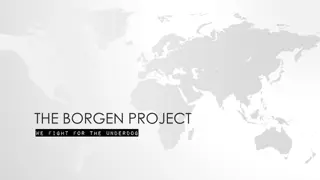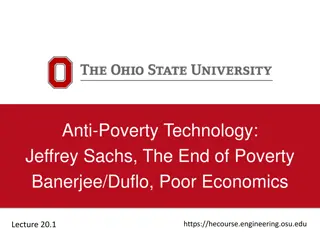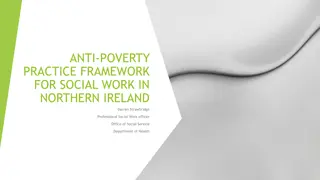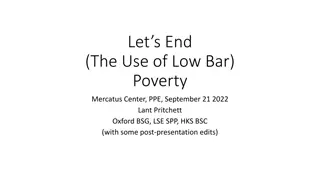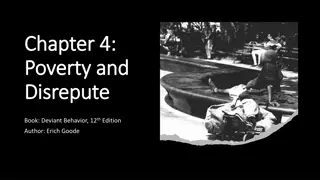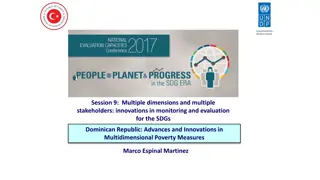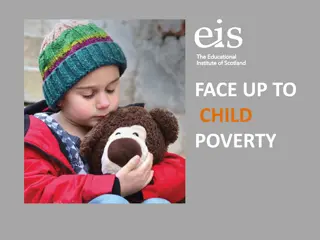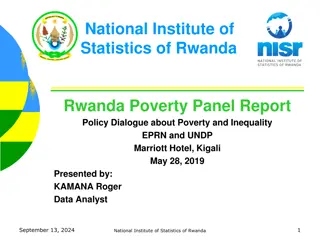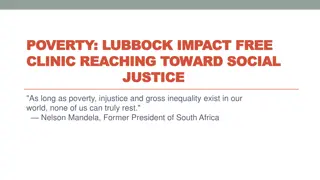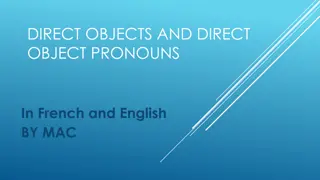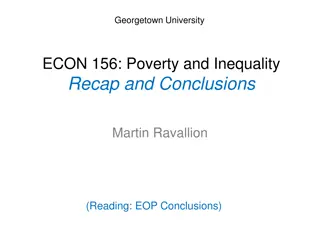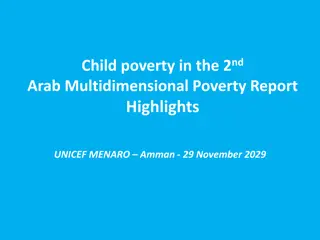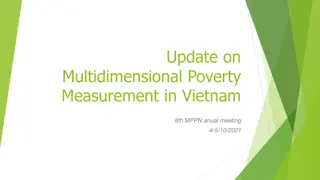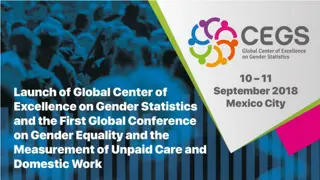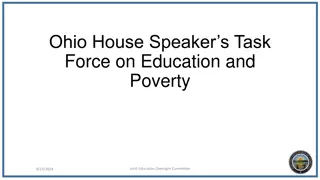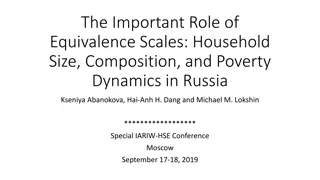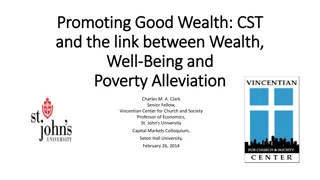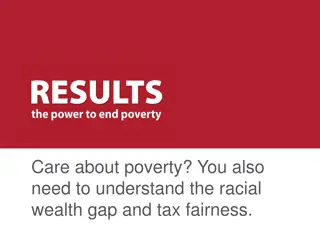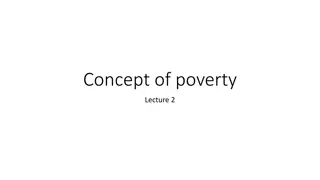Understanding Poverty and Direct Interventions in Economics
The lecture notes explore the issues of persistent poverty due to various shocks and the challenges in eliminating global poverty. It discusses the policy debates surrounding direct interventions, economic arguments, constraints, and targeting strategies. The complexity of poverty eradication through transfers is highlighted, emphasizing the need for effective policy reforms.
Download Presentation

Please find below an Image/Link to download the presentation.
The content on the website is provided AS IS for your information and personal use only. It may not be sold, licensed, or shared on other websites without obtaining consent from the author. Download presentation by click this link. If you encounter any issues during the download, it is possible that the publisher has removed the file from their server.
E N D
Presentation Transcript
Georgetown University course ECON 156: Poverty and Inequality Lecture notes to accompany Ravallion sThe Economics of Poverty Part 3; Chapter 10: Direct interventions against poverty Martin Ravallion
Persistent shocks + chronic poverty Continuing threat of macro crises (food price shocks, Global Financial Crisis, Euro crisis) But regular crises from uninsured risk are a fact of life for the world s poorest: Employment shocks Health shocks (incl. epidemics) Agro-climatic shocks So is chronic poverty a fact of life; even with the progress that has been made against extreme absolute poverty
Is it easy to eliminate poverty? It has often been noted that the world s aggregate poverty gap is modest when one uses poverty lines typical of low-income countries. Recall from Part 3.1 => Example: Annie Lowrie (NYT, Feb 2017): the global poverty gap is roughly what Americans spend on lottery tickets every year, and it is about half of what the world spends on foreign aid. The implication drawn is that it should be relatively easy to eliminate global poverty. Is that right? 3
Recall: Global poverty gap World (including the OECD countries) GDP per capita was $24.58 per day, implying that the global aggregate PG was 0.33% of global GDP using the $1.25 line and 1.28% using $2. $670bn; $166bn for $1.25 a day (2005 PPP) Poverty gap ($2) The rest of world GDP 4
This lecture: The policy issues, debates and lessons for policy reform The policy problem: Defining the role of direct interventions. The economic arguments for and against: constraints (information, incentives), trade-offs, targeting. Examples from actual policy experiences. We will see that eliminating poverty using transfers is a much bigger problem that the poverty gap calculation suggests.
Policy debates on social protection (EOP Chapter 10) The incentives debate The targeting debate Political economy of targeting Policies that try to promote as well as protect 6
Chronic poverty and pervasive risks Number of poor in millions Poverty is pervasive, by both a common international line and by lines typical of the country of residence. 3000 2500 Relatively poor 2000 1500 1000 Absolutely poor 500 0 1981 1984 1987 1990 1993 1996 1999 2002 2005 2008 So too is uninsured risk: Employment shocks Health shocks (incl. epidemics) Agro-climatic shocks 8
Growth is not sufficient (Recap Part 3.2) Relative inequality is rising in some growing countries, though falling in others. Rising absolute inequality in most growing countries. Economic growth has come with lower absolute poverty, but it has had much less impact on relative poverty. Losers as well as gainers. Churning. New evidence that the poorest are left behind. It may well be harder to reach the poorest. Growth in market economies leaves continuing downside risk everywhere, at virtually all income levels. 9
Historical role of Social Safety Net (SSN) As countries develop, they tend to rely more on social policies, esp. social safety nets, combining public insurance and current assistance for those in need. A number of possible reasons why: Harder to reach poorest through growth alone Democratization coming with development External demands to compensate losers from adjustment Income effect on the demand for SSN Better administrative capabilities for SSN policies. 10
Governments in the developing world are turning to direct interventions SSNs were sparse in developing world prior to 1990. Since 2000, many developing countries have implemented SSNs. Today, about one billion people in developing countries receive some form of social assistance. Most developing countries now have at least one such program (however small). The percentage of the population receiving help from the SSN is growing at 3.5% points per annum! 11
One billion poor; one billion SSN recipients Living in poverty Receiving help from SSN But mostly not the same people in poor countries! 12
Richer countries tend to be better at reaching their poor 13
Cruel irony: Poorer countries are less effective in reaching their poor Safety net coverage for poorest quintile (%) Safety net coverage for whole population (%) 100 Poorest quintile 80 Population 60 40 20 0 0 2000 4000 6000 8000 10000 12000 14000 16000 18000 20000 22000 GDP per capita at PPP for year of survey 14 Data from World Bank s ASPIRE site: http://datatopics.worldbank.org/aspire/indicator_glance.
There is a variance in performance Safety net coverage for poorest quintile (%) Safety net coverage for whole population (%) 100 Some poor countries do better than others in reaching their poor. Poorest quintile 80 Population 60 40 20 0 0 2000 4000 6000 8000 10000 12000 14000 16000 18000 20000 22000 GDP per capita at PPP for year of survey Compared to today s poor countries, today s rich countries appear to have done better at reaching their poorest when those countries were poor. 15
Protection + promotion Twin objectives of social policy: promotion and protection. How should we understand this distinction? 17
The roles for SSN policy depend on existing markets and institutions Some argue against intervention in market outcomes that the pie will be larger without intervention, allowing more scope for post-market redistribution. Against this view, the conditions for markets to be efficient in the absence of intervention do not hold in reality and deviations from efficiency have important implications for equity. The separation between efficiency and equity is hard to maintain with incomplete/imperfect markets. 18
Recall the idea of a wealth poverty trap (Part 3.2) Three equilibria, A,B,C, but only A and C are stable. Wealth poverty trap at A. Positive consumption (=income) for those at A. And uninsured risk => transient income fluctuations. t w + 1 = ( ) w w C + 1 t t B t w A min k ) 1 + * /( k 19
Two long-run classes in stable steady states In the long run, after repeated small shocks, the economy will settle in a state that can be thought of as having two main classes of people. One class has little or no wealth, given that its members are caught in a wealth poverty trap, at point A. There can be many reasons in practice why people are so trapped, including lack of any marketable skills, social exclusion, geographic isolation, debilitating disease, or environmental degradation. The second class comprises people who have settled at point C, at their respective steady-state levels of wealth. 20
There can be steady-state poverty with or without a trap There can still be inequality within each class. There can be inequality of labor earnings amongst the poorer class, and there can be wealth inequality amongst the point C folk, given different steady-state levels of wealth. There can be poverty even if nobody is caught in a poverty trap. The poor can be identified as two groups of people: those at point A and the poor amongst those at point C, i.e., those for whom their steady-state level of wealth turns out to be very low, even though they are not caught in a poverty trap. 21
Two types of antipoverty policies 1. Protection policies provide short-term palliatives by assuring that current consumptions do not fall below some crucial level, even when some are trapped. 2. Promotion policies either: (i) Allow poor people to break out of the trap, by permitting a sufficiently large wealth gain, to put them on a path to reach their (higher and stable) steady state wealth, or (ii) Raise productivity for those not trapped. Protection has a long history (ancient Asia and Europe). Promotion is a modern idea (from late C18th). 22
Two types of promotion policies t w Type 2 Type 1: If destitute (at A), then a large enough gain in wealth will get you onto the path to point C. Type 2: Raising productivity at all levels of initial wealth: with sufficient gain in productivity the trap will vanish. + 1 = ( ) w w C + 1 t t B t w A min k ) 1 + * /( k Type 1 23
The incentives debate: A protection-promotion trade-off? (EOP Section 10.2) Many policies combine aspects of both promotion and protection. But can we have more of both? Or is there a trade-off? 24
Promotion Protection limits promotion but how much? Protection- Promotion Trade-off While policy makers typically want SSN to assure a minimum standard of living, this may discourage personal efforts to escape poverty by other means. Incentive effects on work, fertility, savings. Protection-Promotion Tradeoff (PPT). Protection The optimum is unlikely to be either at full protection or no protection but maximum promotion. 25
The longstanding debate on incentives Policy makers typically want the social safety net (SSN) to assure a minimum standard of living. One side of the debate: This will discourage personal efforts to escape poverty by other means. Dependency. This side of the debate points to behavioral responses through work effort, savings, fertility and family formation are often sited as adverse incentive effects of a SSN. 26
The other side of the debate: Trade-off is exaggerated. Incentives not an issue In an under-employed economy: If there is excess capacity (unemployment), a fiscal stimulus concentrated on the poor is likely to bring a short-term gain to aggregate effective demand, and hence output. Poorer people have higher marginal propensity to consume from income gains. Keynes s General Theory, Chapter 24 (EOP, Box 1.22). In a fully employed economy: The idea of an inevitable long-run tradeoff can also be questioned: Multiple equilibria, poverty traps Credit market failures + diminishing marginal products Political economy 27
The debate on incentives for risk-taking Moral hazard in social protection? One side of the debate: Using public money to help those who took high risks, and lost out, can encourage excessively risky behavior in the future. ( Moral hazard ) The other side: Here too the trade-off is exaggerated. Uninsured risk can spill over into production and investment decisions of poor people in ways that can severely impede longer-term prospects of escaping poverty. Taking kids out of school Forgoing investment in own enterprise Poverty trap: protection from large negative shocks my be crucial for sustained promotion. Lack of insurance for the poor is probably a more important reason for persistent poverty than too much insurance! 28
Incentives depend on program design While incentive issues have often been exaggerated, they should not be ignored. The incentive effects depend on the design of the program, esp., how finely targeted it is. Fine targeting can have adverse incentive effects. In an effort to better focus antipoverty efforts on poor people there have been many proposals for more finely targeted policies; transfer received falls rapidly with higher income. More inclusive, less targeted programs, tend to have better incentive effects. 29
The Benefit Withdrawal Rate In any means-tested ( targeted ) program there will be some reduction in the transfer paid as pre-transfer income rises. The rate at which transfer received falls as income rises is the Benefit Withdrawal Rate or Marginal Tax Rate (MTR). (Think of the transfer as a negative tax.) Fine targeting can create a high MTR on poor families, with adverse incentive effects. When the MTR for a program (or set of programs) gets close to 100% then incentive effects become a major concern. At moderate MTRs (say around 50%), there is much less reason to worry about incentive effects. 30
Example: Do transfers reduce work effort in South Africa? South Africa s old-age pension: paid to all women over 60 and men over 65. In practice everyone who is eligible gets the transfer about double the median income. With some degree of income pooling within households, the simple economics of work-leisure choice would imply that this transfer reduced work. That is not what happened! Panel data suggest that the pension helped families get around credit constraints on out- migration by younger adult family members (often leaving the pensioner to look after the kids). 31
Other constraints on the policy problem Incentive effects have dominated economic analysis, but other constraints may well matter more in practice. Information/administration: The poor in developing countries are not so easily identified; means testing is rarely feasible. State capacity is often weak, leading to corruption/wastage. Measurement errors confound assessments of targeting. The appearance of poor targeting can stem from errors in assessing who is really poor! Proxy-means tests often have poor predictive ability; large targeting errors. Better social protection (incl. crisis preparedness) requires investments in better data. 32
Information constraints Data constrain policy: incentives to miss-report; costs of data collection. Better social protection (incl. crisis preparedness) requires investments in better data. Huge improvement in survey data design and availability, though continuing concerns about data quality. Priors on the ground (field work) can contain useful clues. Sound social policies also requires thinking about incentives and program design, given information constraints and administrative capacity. 33
Political economy constraints Political economy: Programs for the poor are poor programs (Larry Summers) Recall median voter model. Even when inequality is high (high mean/median) if the median voter does not benefit sufficiently (since the money only goes to the poor) then there will be little support for redistribution. Transfer from rich to poor bypassing median voter 34
Agency problems by levels of government Promotion Local The weight given to promotion relative to protection may depend on the level of government. Moral hazard: Risks are not fully covariate. Local government can expect center to help in a crisis. Protection- Promotion takeoff Center Protection So local implementing agents may well undervalue protection relative to the center. Political economy (staying in power) may also lead the center to put too high a weight on protection relative to promotion. 35
Challenges in making a pro-poor safety net politically sustainable State-contingent safety net programs that provide insurance will have a broader base of supporters than the direct beneficiaries. Unclear that the middle class will support safety net reform, especially when it takes the form of targeted programs for the poorest. Programs that impose conditions on recipients to change their behavior in ways that will reduce future poverty will invariably get broader public support. Though there may well be trade-offs here too; impacts on current poverty may be lower due to forgone labor earnings. 36
The targeting debate: Universal provision vs. fine targeting (EOP Section 10.2, pp.560-2) 37
Recall: Information constraints The poor in developing countries are not so easily identified; means testing is rarely feasible. State capacity is often weak. Corruption. Data constrain policy: incentives to miss-report; costs of data collection. Better social protection (incl. crisis preparedness) requires investments in better data. Huge improvement in survey data design and availability, though continuing concerns about data quality. Priors on the ground (field work) can contain useful clues. 38
One possible solution: Basic Income Everyone receives the same transfer, poor or not Variously called universal basic income (UBI), basic income guarantee (BIG), citizenship income ) Very little information is required. But we typically do have some information on who is poor and who is not. Few incentive effects of the transfer, good or bad (only income effect on demand for leisure) Nothing you can do to change the amount received! No built in mechanism for responding to shocks 39
BIG tradeoffs A large uniform cash transfer financed by (say) progressive income tax => large gains to poor people. However: Why should we ignore the information we do have on who is likely to be poor and who is not? What is the cost to promotion from poverty through other means (health and schooling)? A better idea? Basic Full Income, incl. imputed values for in-kind spending on health and education. Forces the public awareness and articulation of the trade- offs. Public debate about values. 40
Dont forget about financing! Suppose that the UBI/BIG is financed by progressive income tax (EOP: Box 10.3) A BIG is introduced, giving a transfer b to everyone, financed by a tax at the rate t on all incomes. The scheme is configured such that the net benefits are greatest for the poorest but remain positive up to the poverty line, after which there is a net loss. Initial income distribution (y(p)) Final post-benefit incomes (b+(1-t)y(p)) Income (y) Quantile functiony(p) Incomes after taxation but before the basic income is added ((1-t)y(p)) Poverty line (z) A b Percentile of the population ranked by income (p) Headcount index of poverty (H) 41
Some BIG myths No incentive effect : but don t forget the income effect: people who don t like work will work less (EOP Box 1.4). But maybe they work too much! Welfare losses + less investment in early childhood development. Although the information problem of identifying poor people no longer arises for the UBI/BIG, this advantage is likely to be lost once the scheme is financed. If one still wants to assure that only the poor receive a net gain, then the information/incentives problem returns. There will be a negative income tax scheme that can achieve the same final distribution of income as a BIG. In last slide: those with an income below z incur negative taxes while those above z pay positive taxes. 42
Subsidies on normal goods A more common form of untargeted transfer is the use of universal subsidies on normal goods Still widespread use of subsidies on food, fuel housing etc. Potentially large cost, which leaves fewer public resources for other things relevant to promotion And not much protection either: relatively little goes to the poor; unresponsive to shocks Also environmental concerns about fuel subsidies; fossil fuel consumption should be taxed not subsidized. Current beneficiaries resist reform efforts Riots in Paris in Fall 2018 led to reversal. 43
Recall the cruel irony: Poorer countries are less effective in reaching their poor Safety net coverage for poorest quintile (%) Safety net coverage for whole population (%) 100 Poorest quintile 80 Population 60 40 20 0 0 2000 4000 6000 8000 10000 12000 14000 16000 18000 20000 22000 GDP per capita at PPP for year of survey 44
For and against targeting One side: By targeting poor people we can assure greater impact on poverty for the same aggregate outlay or spend less to obtain the same impact on poverty. Emphasis on inclusion errors (benefits to non-poor people) The other side: Concerns about incentive effects, though imperfect information dulls these concerns. Targeting is imperfect in practice, esp., high exclusion errors (leaving out poor people). Targeting errors include errors in measuring economic welfare. Targeting comes with hidden costs, and may undermine the broad political consensus for social protection 45
Example: Targeting transfers in Kyrgyzstan using a proxy-means test 46 Source: Development Pathways blog post.
Targeting can help, but it is not the objective The most finely targeted policy need not have the most impact on poverty. Costs of fine targeting: administration; costs imposed on participants Information problems; measurement errors Measurement errors confound assessments of targeting. Proxy Means Tests (PMT): regression based using a survey to calibrate the PMT; but how good? The appearance of poor targeting can stem from errors in assessing who is really poor! Potential for adverse incentives: high marginal tax rates=>poverty traps. (EOP: Box 10.1) 47
The $200 billion gap The total poverty gap the total sum of money that would bring everyone up to $1.25 a day at 2005 PPP was $200bn in 2005. This is less than one quarter of the $800bn fiscal stimulus passed by the US government in 2009. However, the cost of eliminating poverty by transfers could well be far higher than $200bn, given incentive effects, information problems and political economy. The problem is a lot harder! Quantile function: y(p) H 48
Perfect targeting can create a poverty trap Advocates of finely targeted policies often observe that the aggregate poverty gap can be rather small. However, this understates the likely cost of perfectly targeted transfers given behavioral responses. High marginal tax rates reduce the incentive to escape poverty and increase the fiscal cost of the policy. Income of pth percentile Aggregate poverty gap H 49
Perfect targeting can create a poverty trap Advocates of finely targeted policies often observe that the aggregate poverty gap can be rather small. However, this understates the likely cost of perfectly targeted transfers given behavioral responses. High marginal tax rates reduce the incentive to escape poverty and increase the fiscal cost of the policy. Cost can rise to zH due to work diss-incentive Aggregate poverty gap H 50






